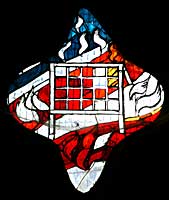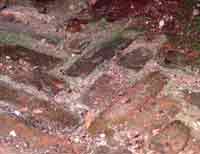Towcester's origins can be traced back to the arrival of the Romans when the walled garrison town was initially given the Roman name of "Lactodorum". The church is dedicated to a Roman saint, St Lawrence, who was a deacon of the church in Rome in the third century, He was martyred in Rome in the year 258, slowly roasting to death on a grid iron, during the persecution of Christians under the emperor Valerian. The grid iron remains the usual emblem of St Lawrence. He is the subject of the modern stained glass window in the south porch.
There is a good deal of evidence to suggest that the Romans had previously constructed a substantial building on the site now occupied by St Lawrence Church. Sir Henry Dryden's excavations in1883, under and around the south porch, have uncovered tiles from their hypocaust, which provided the building with heating.
Box flue tiles, pilae and hollow box voussoir tiles have also been found. The discovery of a piece of quarter-rounded, blue painted cement moulding which would have been part of hot or cold plunge bath, is further evidence that this site may have been the bath house of a mansio (major administrative building).
Areas of Roman herringbone brick flooring (opus spicatum) remain and a section of herringbone flooring can still be seen from the outside boiler house staircase to the east of the south porch. The bricks (12cm x 8cm x 4cm) are set edgeways in pink Roman cement. The first south wall of the church sits on this flooring.


